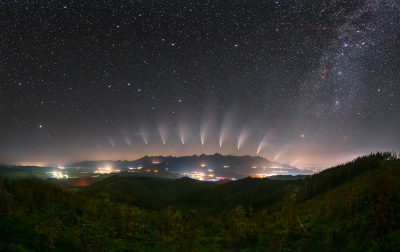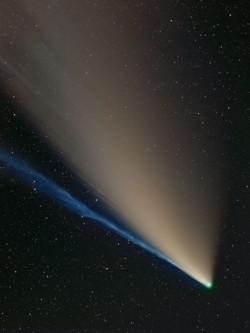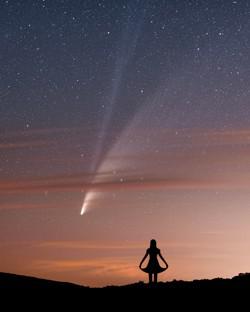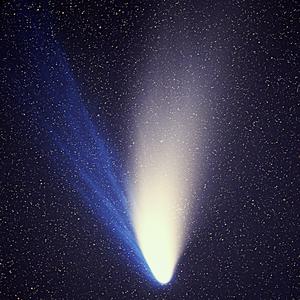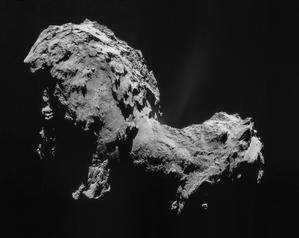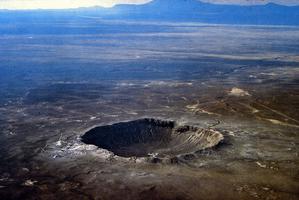Glossary term: Comet
Description: A comet is a small object in the Solar System consisting of a nucleus made up of a mixture of different types of ice and rocky, dusty material – a dirty snowball. Comet nuclei can range in size from a few hundred meters to tens of kilometers across. Most comets have highly elliptical orbits. When the comet approaches the Sun, some of the surface ice evaporates and is blown back by the solar wind to form the distinctive coma and tail features. We see comets due to the sunlight reflecting off the coma or tail or (for comets far from the Sun) the nucleus. Comets are classified as either "periodic" or "short-period" if their passage has been observed more than once, or their period is known to be less than 200 years, and "non-periodic" otherwise.
Related Terms:
See this term in other languages
Term and definition status: This term and its definition have been approved by a research astronomer and a teacher
The OAE Multilingual Glossary is a project of the IAU Office of Astronomy for Education (OAE) in collaboration with the IAU Office of Astronomy Outreach (OAO). The terms and definitions were chosen, written and reviewed by a collective effort from the OAE, the OAE Centers and Nodes, the OAE National Astronomy Education Coordinators (NAECs) and other volunteers. You can find a full list of credits here. All glossary terms and their definitions are released under a Creative Commons CC BY-4.0 license and should be credited to "IAU OAE".
If you notice a factual error in this glossary definition then please get in touch.
Related Media
Neowise's metamorphosis, by Tomáš Slovinský and Petr Horálek, Slovakia
Credit: Tomáš Slovinský and Petr Horálek/IAU OAE
License: CC-BY-4.0 Creative Commons Attribution 4.0 International (CC BY 4.0) icons
Comet C/2020F3 (Neowise) with separate dust and ion gas tails and a green glowing coma, by Dietmar Gutermuth, Germany
Credit: Dietmar Gutermuth/IAU OAE
License: CC-BY-4.0 Creative Commons Attribution 4.0 International (CC BY 4.0) icons
Hello Comet, shall we dance?, by Robert Barsa, Slovakia
Credit: Robert Barsa/IAU OAE
License: CC-BY-4.0 Creative Commons Attribution 4.0 International (CC BY 4.0) icons
Comet Hale-Bopp
Credit: E. Kolmhofer, H. Raab; Johannes-Kepler-Observatory, Linz, Austria credit link
License: CC-BY-SA-3.0 Creative Commons Attribution-ShareAlike 3.0 Unported icons
Comet 67P/Churyumov-Gerasimenko
Credit: ESA/Rosetta/NAVCAM credit link
License: CC-BY-SA-3.0-IGO Creative Commons Attribution-ShareAlike 3.0 IGO icons
Related Activities
Meteoroids, Meteors and Meteorites
astroEDU educational activity (links to astroEDU website) Description: Unveiling the mystery of "shooting stars": meteors, meteorites and meteroids
License: CC-BY-4.0 Creative Commons Attribution 4.0 International (CC BY 4.0) icons
Tags:
Geology
Age Ranges:
6-8
, 8-10
, 10-12
, 12-14
Education Level:
Middle School
, Primary
Areas of Learning:
Interactive Lecture
Costs:
Low Cost
Duration:
1 hour 30 mins
Group Size:
Group
Skills:
Analysing and interpreting data
, Asking questions
, Communicating information
, Engaging in argument from evidence
Measuring the average speed of a comet
astroEDU educational activity (links to astroEDU website) Description: Using telescope images of comet C/2019 Y4 we calculate its average speed and understand what a physical quantity is
License: CC-BY-4.0 Creative Commons Attribution 4.0 International (CC BY 4.0) icons
Tags:
Software
, average speed
Age Ranges:
12-14
, 14-16
, 16-19
, 19+
Education Level:
Secondary
Costs:
Free
Duration:
1 hour 30 mins
Group Size:
Group
Skills:
Analysing and interpreting data
, Developing and using models
, Engaging in argument from evidence
